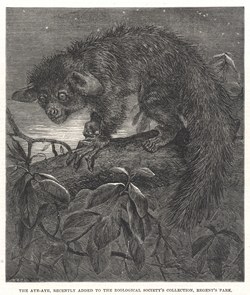|
|
|
|

| Illustrator: S. C. Pearson. |
| Language: English |
| No. of Pages: 1 |
|
| Item Identification Code (UID#): 3052 |
| Shelving Location: Book Leaves |
| Estimated Value: £15.00 |
Log In to Edit this page
|
The aye-aye, recently added to the Zoological Society's collection, Regent's Park
Illustrated London News, 6 September 1862
|
|
|
The Illustrated London News (1862).
|
|
Newspaper Cutting
An antique wood-engraved print of the first aye-aye (Daubentonia madagascariensis) specimen to reach England.
|
Notes
|
- This engraving appeared in The Illustrated London News accompanied by the following short article:
The aye-aye (Chiromys Madagascariensis) is one of the rarest and least known of the monkey tribe, and is further remarkable for its extraordinarily remarkable anomalous structure in several particulars, which induced the celebrated Cuvier to class it amongst the rodents, or gnawing animals. The aye-aye was discovered by the French traveller Sonnerat, in the forests of Madagascar, during the latter part of the last century. It received its name from the expression of surprise said to have been used by the natives when it was first seen; for, according to Sonnerat’s statements, it was hardly known even to the inhabitants of the island before the time of his visit. The two specimens of this animal thus obtained were transferred to the collection of natural history in the Jardin des Plantes at Paris, and remained for many years the only examples of their kind in Europe. In 1858, Dr. H. Sandwith (of Kars), then Colonial Secretary of the Island of Maurtius, obtained a living example of the aye-aye from Madagascar, and read an interesting paper on its habits, as displayed in a state of captivity, before the Royal Society of Arts and Sciences of that colony. This specimen, being shortly afterwards sent to England to Professor Owen, formed the subject of a very complete and elaborate memoir upon the structure of the aye-aye, which was recently communicated by that distinguished naturalist to the Zoological Society of London, and will shortly be published in their "Transactions".
The Zoological Society have now also succeeded in obtaining the first specimen of this curious mammal that has reached Europe alive. Edward Mellish, Esq., of the Mauritius, one of the gentlemen who formed the mission sent last year to congratulate King Radama II. on his accession to the throne pf the Hovas, knowing the interest that attached itself to the aye-aye, made great exertions to procure a living specimen. At the time of his visit to Madagascar Mr. Mellish did not succeed in this object; but having recently been more successful, through the assistance of some correspondents in that island, most liberally transmitted a fine full-grown example of this animal by the last overland mail to the Zoological Society of London, to be added to their splendid collection of living animals in Regent’s Park. The aye-aye reached England in safety, though in rather poor condition from the effects of confinement and want of its habitual food during the transport home. It is now rapidly recovering itself, though, from its nocturnal habits and health being not quite re-established, it is not yet visible to the ordinary visitors to the gardens.
|
Categories
|
|
|
|
BUY FROM AMAZON.COM
Browse 100s More Titles in our Madagascar Book Store
|
Photographs of the Item (Total: 1)
|
|
Click image to see larger:
|
|
© 2006–2025 Daniel Austin
|